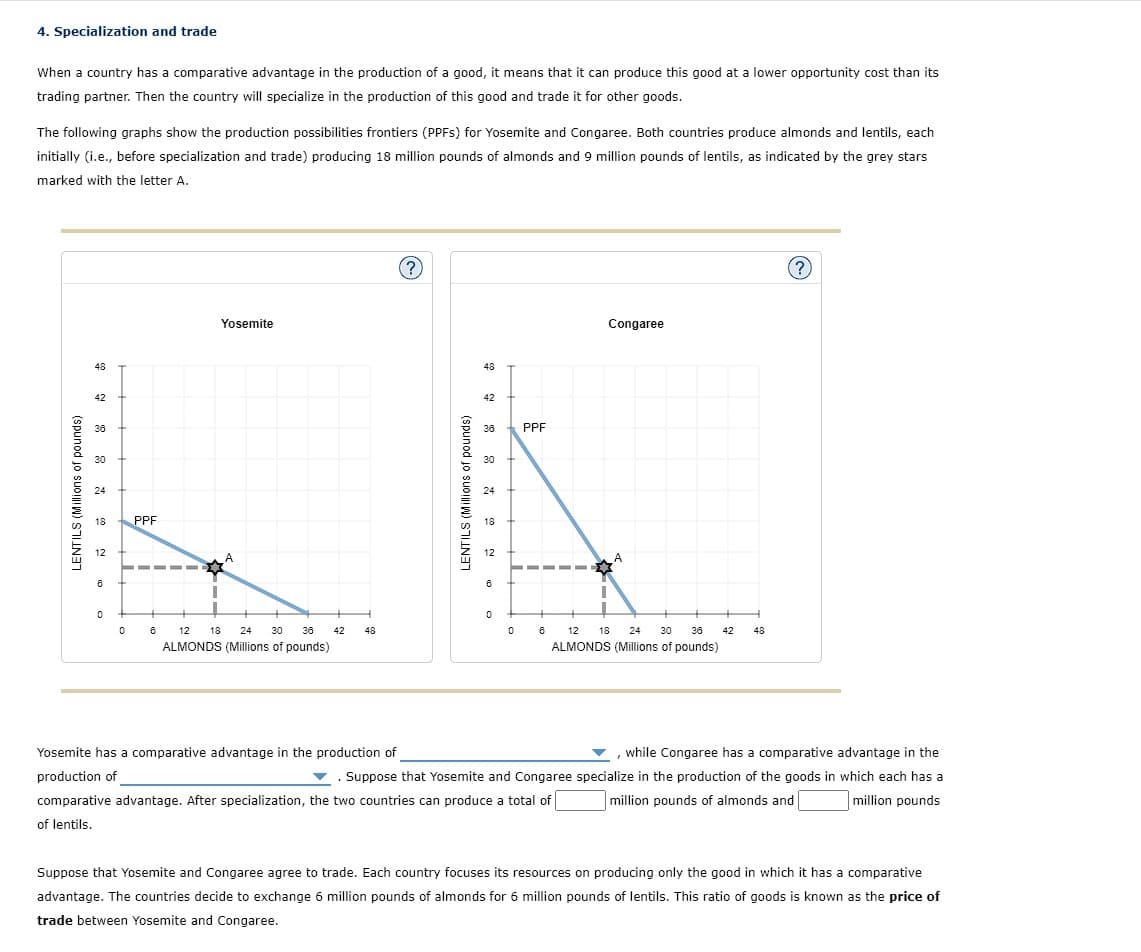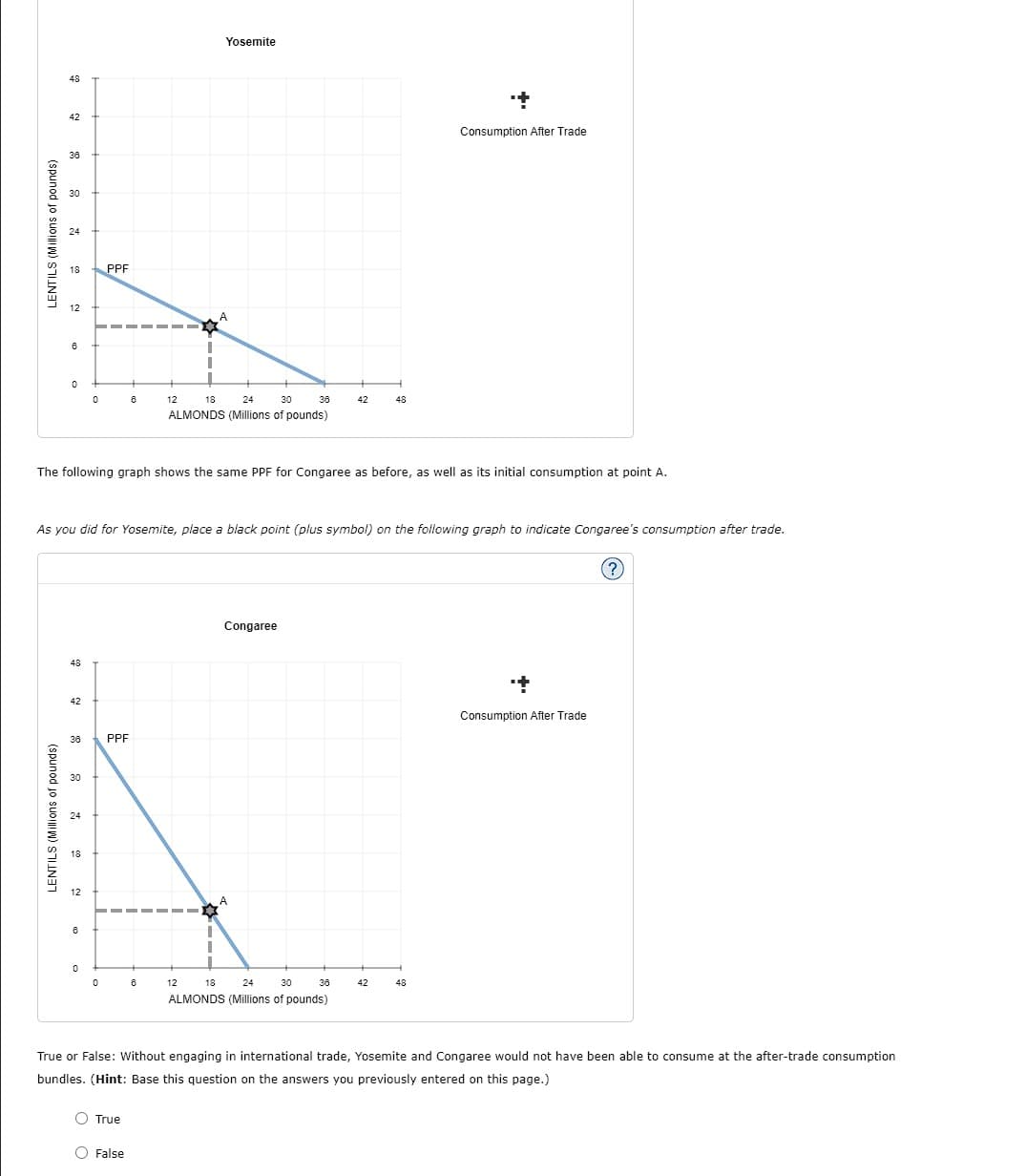Yosemite has a comparative advantage in the production of , while Congaree has a comparative advantage in the ▼. Suppose that Yosemite and Congaree specialize in the production of the goods in which each has a million pounds production of comparative advantage. After specialization, the two countries can produce a total of million pounds of almonds and of lentils.
Yosemite has a comparative advantage in the production of , while Congaree has a comparative advantage in the ▼. Suppose that Yosemite and Congaree specialize in the production of the goods in which each has a million pounds production of comparative advantage. After specialization, the two countries can produce a total of million pounds of almonds and of lentils.
Chapter7: Economic Growth: Theory And Policy
Section: Chapter Questions
Problem 4TY
Related questions
Question
Economy

Transcribed Image Text:4. Specialization and trade
When a country has a comparative advantage in the production of a good, it means that it can produce this good at a lower opportunity cost than its
trading partner. Then the country will specialize in the production of this good and trade it for other goods.
The following graphs show the production possibilities frontiers (PPFS) for Yosemite and Congaree. Both countries produce almonds and lentils, each
initially (i.e., before specialization and trade) producing 18 million pounds of almonds and 9 million pounds of lentils, as indicated by the grey stars
marked with the letter A.
LENTILS (Millions of pounds)
48
42
36
30
24
18
12
6
0
PPF
=====
0
6
Yosemite
12 18 24 30 38
ALMONDS (Millions of pounds)
42
48
(?)
LENTILS (Millions of pounds)
48
42
36
30
24
18
12
6
0
0
PPF
6
Congaree
A
12 18 24 30 36 42 48
ALMONDS (Millions of pounds)
(?)
Yosemite has a comparative advantage in the production of
while Congaree has a comparative advantage in the
production of
Suppose that Yosemite and Congaree specialize in the production of the goods in which each has a
comparative advantage. After specialization, the two countries can produce a total of
million pounds of almonds and
million pounds
of lentils.
Suppose that Yosemite and Congaree agree to trade. Each country focuses its resources on producing only the good in which it has a comparative
advantage. The countries decide to exchange 6 million pounds of almonds for 6 million pounds of lentils. This ratio of goods is known as the price of
trade between Yosemite and Congaree.

Transcribed Image Text:LENTILS (Millions of pounds)
48
42
LENTILS (Millions of pounds)
36
30
18 PPF
12
6
0
48
42
36 PPF
30
24
18
0
12
The following graph shows the same PPF for Congaree as before, as well as its initial consumption at point A.
6
As you did for Yosemite, place a black point (plus symbol) on the following graph to indicate Congaree's consumption after trade.
0
0
8
O True
O False
12
6
1
|
18
24
30
ALMONDS (Millions of pounds)
Yosemite
12
36
Congaree
A
24
30
18
ALMONDS (Millions of pounds)
42
36
48
42
Consumption After Trade
48
+
Consumption After Trade
True or False: Without engaging in international trade, Yosemite and Congaree would not have been able to consume at the after-trade consumption
bundles. (Hint: Base this question on the answers you previously entered on this page.)
(?)
Expert Solution
This question has been solved!
Explore an expertly crafted, step-by-step solution for a thorough understanding of key concepts.
This is a popular solution!
Trending now
This is a popular solution!
Step by step
Solved in 6 steps

Knowledge Booster
Learn more about
Need a deep-dive on the concept behind this application? Look no further. Learn more about this topic, economics and related others by exploring similar questions and additional content below.Recommended textbooks for you

